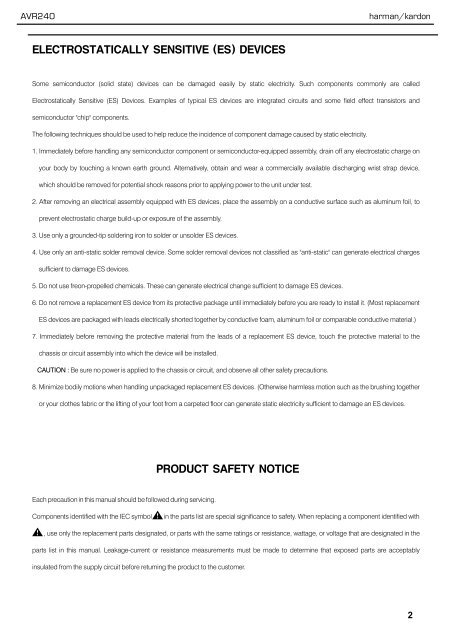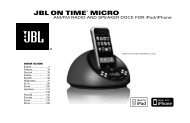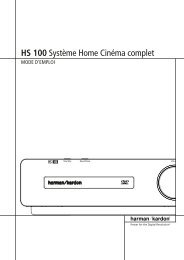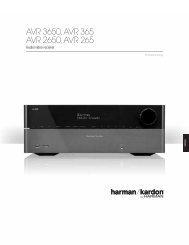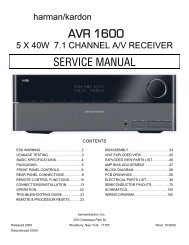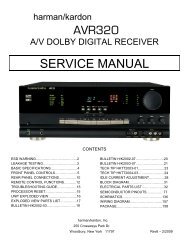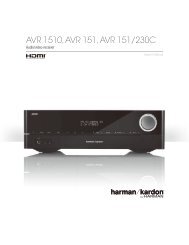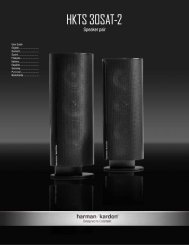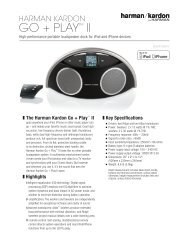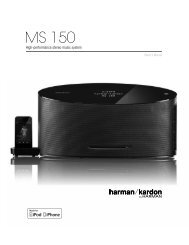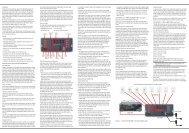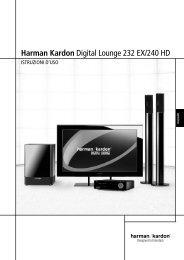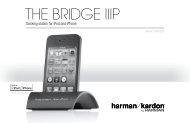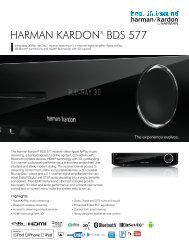AVR 240 OM - Harman Kardon
AVR 240 OM - Harman Kardon
AVR 240 OM - Harman Kardon
You also want an ePaper? Increase the reach of your titles
YUMPU automatically turns print PDFs into web optimized ePapers that Google loves.
<strong>AVR</strong><strong>240</strong><br />
harman/kardon<br />
Some semiconductor (solid state) devices can be damaged easily by static electricity. Such components commonly are called<br />
Electrostatically Sensitive (ES) Devices. Examples of typical ES devices are integrated circuits and some field effect transistors and<br />
semiconductor "chip" components.<br />
The following techniques should be used to help reduce the incidence of component damage caused by static electricity.<br />
1. Immediately before handling any semiconductor component or semiconductor-equipped assembly, drain off any electrostatic charge on<br />
your body by touching a known earth ground. Alternatively, obtain and wear a commercially available discharging wrist strap device,<br />
which should be removed for potential shock reasons prior to applying power to the unit under test.<br />
2. After removing an electrical assembly equipped with ES devices, place the assembly on a conductive surface such as aluminum foil, to<br />
prevent electrostatic charge build-up or exposure of the assembly.<br />
3. Use only a grounded-tip soldering iron to solder or unsolder ES devices.<br />
4. Use only an anti-static solder removal device. Some solder removal devices not classified as "anti-static" can generate electrical charges<br />
sufficient to damage ES devices.<br />
5. Do not use freon-propelled chemicals. These can generate electrical change sufficient to damage ES devices.<br />
6. Do not remove a replacement ES device from its protective package until immediately before you are ready to install it. (Most replacement<br />
ES devices are packaged with leads electrically shorted together by conductive foam, aluminum foil or comparable conductive material.)<br />
7. Immediately before removing the protective material from the leads of a replacement ES device, touch the protective material to the<br />
chassis or circuit assembly into which the device will be installed.<br />
CAUTION : Be sure no power is applied to the chassis or circuit, and observe all other safety precautions.<br />
8. Minimize bodily motions when handling unpackaged replacement ES devices. (Otherwise harmless motion such as the brushing together<br />
or your clothes fabric or the lifting of your foot from a carpeted floor can generate static electricity sufficient to damage an ES devices.<br />
Each precaution in this manual should be followed during servicing.<br />
Components identified with the IEC symbol<br />
in the parts list are special significance to safety. When replacing a component identified with<br />
, use only the replacement parts designated, or parts with the same ratings or resistance, wattage, or voltage that are designated in the<br />
parts list in this manual. Leakage-current or resistance measurements must be made to determine that exposed parts are acceptably<br />
insulated from the supply circuit before retuming the product to the customer.


